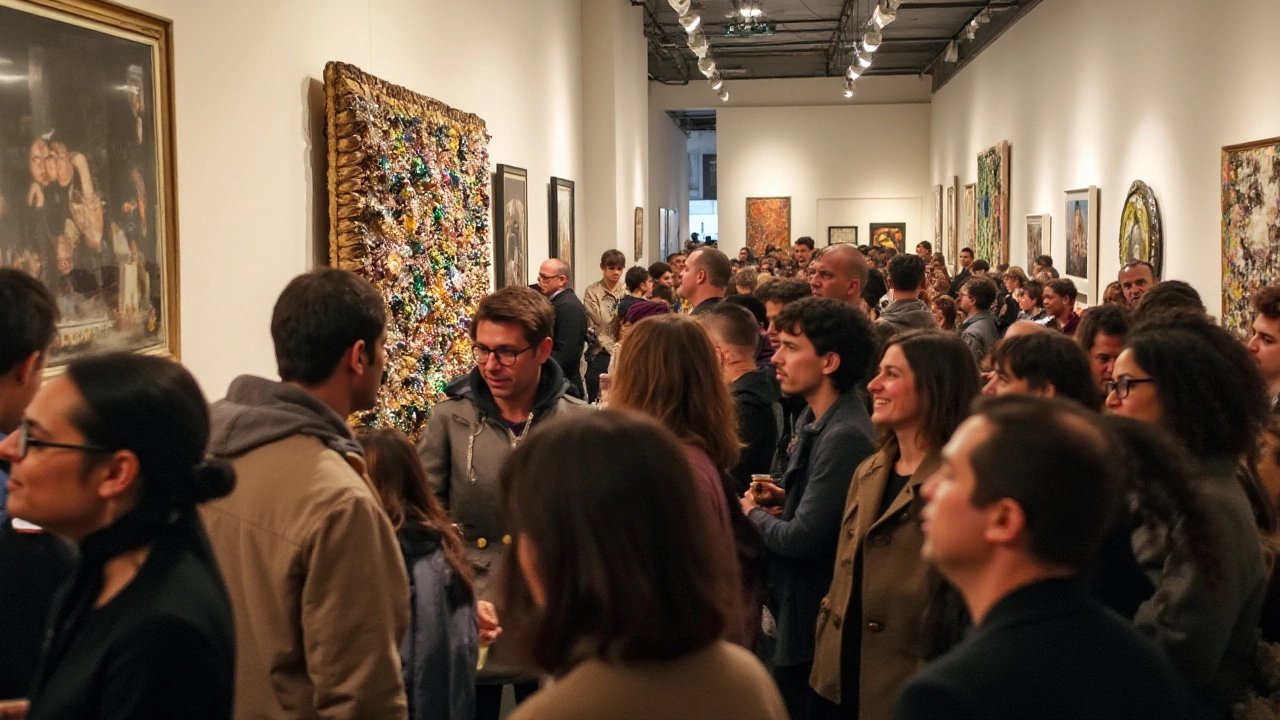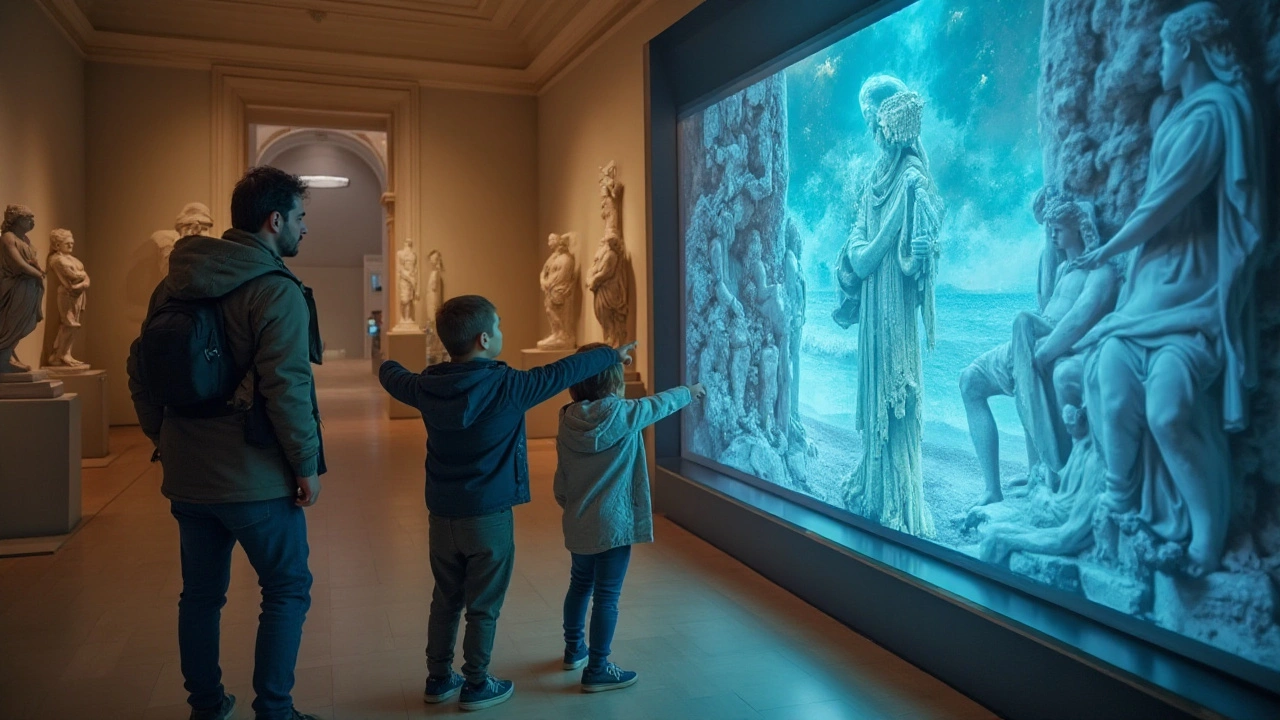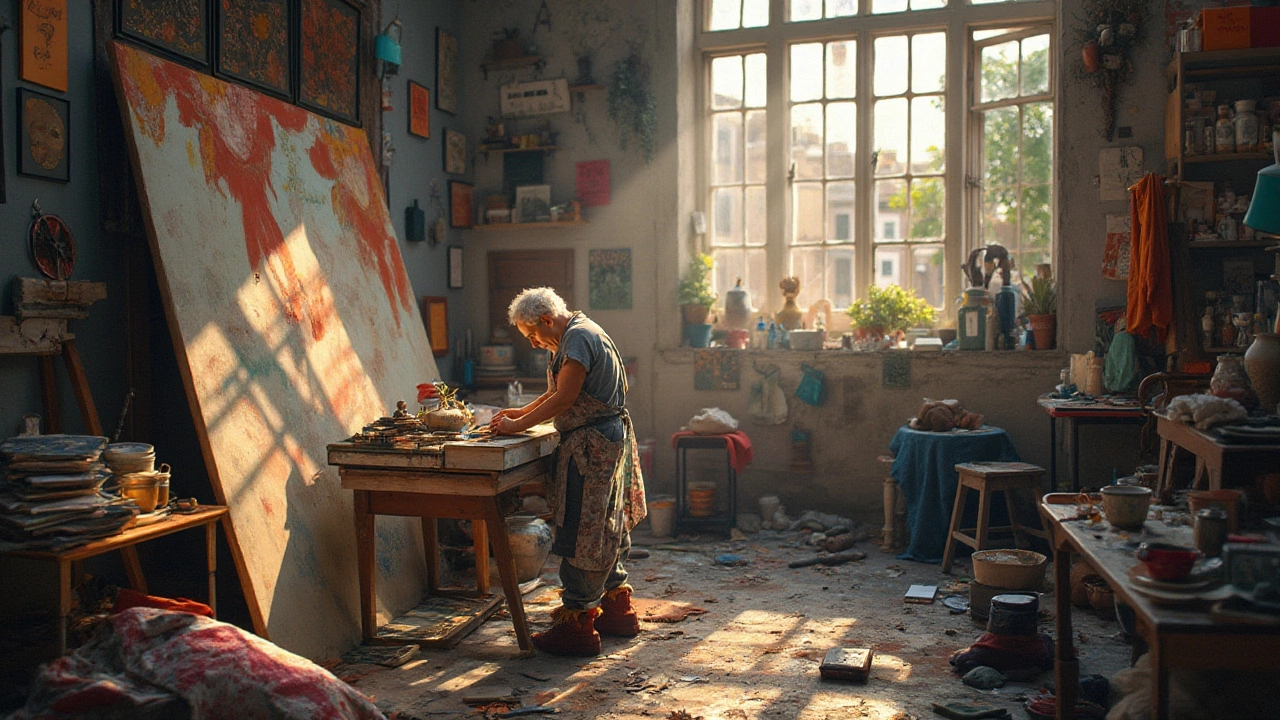Modern art stands as a testament to the restless creativity of humankind, forever shaping and reshaping the lenses through which we perceive the world. It offers a playful dance of colors, shapes, and textures, often pushing the envelope and challenging preconceived notions of what art should be. But what truly makes a piece of modern art stand out among the rest? It's not merely a matter of personal taste, but rather an intricate interplay of innovation, emotional resonance, and cultural reflection.
As we dive deeper into the lively realm of contemporary art, we'll pinpoint the elements that render it not just aesthetically pleasing, but profoundly impactful. Whether it’s through the daring use of materials or the emotional engagement with its audience, modern art captures the spirit of an era like nothing else. In this exploration, we'll unravel how artists today create magic on canvas, through sculptures, and beyond, forming meaningful dialogues with the viewers and with society at large.
- Defining Modern Art
- Innovative Use of Materials
- Emotional Connections and Viewer Engagement
- Exploring Themes of Modern Society
- Narrative Techniques in Modern Art
- The Role of Critique and Feedback
Defining Modern Art
Modern art is a sprawling, vibrant landscape that often eludes traditional definitions. Emerging prominently in the late 19th century and flourishing throughout the 20th century and beyond, it represents a radical departure from the conventional rules that once governed artistic expression. The rise of this movement aligned with rapid societal changes such as industrialization, scientific advancements, and global conflicts, which deeply influenced artists to break away from realist representation and explore new ideas and forms. Modern art is not confined to a single style or medium; rather, it encompasses a myriad of approaches, from impressionism and cubism to surrealism and abstract expressionism.
One of the defining characteristics of modern art is its embrace of experimentation and individualism. Artists began to view themselves as innovators, using their works to question reality and provoke thought. They traded realistic depiction for subjectivity, driven by the belief that art was more about ideas than mere representation. This paradigm shift is vividly illustrated in the works of pioneers like Claude Monet, whose impressionist renderings shattered traditional perspectives on color and light, and Pablo Picasso, who through cubism, offered multiple views within a single canvas. Their daring boldness set the stage for a new understanding of aesthetics, inviting viewers to interpret and interact with art on a more personal level.
Another crucial element of modern art is its capacity to intermingle with cultural and political themes, reflecting the zeitgeist of its time. With artists taking on roles akin to that of social critics, their works often provoke dialogue on pressing issues, whether it be war, gender, or racial dynamics. Many artists find themselves asking: How does art influence society, and in what ways does society reciprocate? This introspective inquiry is prominent in the thought-provoking works of Frida Kahlo, whose paintings intertwine personal pain with broader cultural identity. Her vivid imagery and symbolic use of indigenous Mexican motifs create a powerful commentary on feminism and identity.
A notable hallmark of modern art includes its approach toward materials and methodology. This era witnessed artists experimenting beyond conventional brushes and canvases, incorporating industrial material, household items, or even the latest technology in their creations. The incorporation of new media and mixed mediums defies traditional borders between disciplines, effectively creating a crossover between visual arts, sculpture, and installation art. Marcel Duchamp's “Fountain,” an ordinary urinal positioned as an artwork, forces viewers to question what art is and who gets to define it. It embodies a democratisation of art, suggesting that meaning is equally in the eye of the beholder as it is in the artist’s intent.
As Quentin Bell astutely noted, “Art is not to do with the practical side of making a living. It’s to live a fuller life.” Art's purpose goes beyond the surface level, delving into deeper truths about existence and human experience, often uncovering facets of ourselves we scarcely acknowledge.Modern art, diverse and dynamic, requires one to look beyond aesthetics and engage with its conceptual depth. It challenges observers to think critically, to question, and to see the world differently, ultimately serving as a mirror to the ever-evolving processes of thought and society.
Innovative Use of Materials
When you think of modern art, it's fascinating to see how artists have expanded their repertoire to include a diverse array of unconventional materials. This exploration of media challenges traditional approaches and breathes new life into the art world. From recycled objects to digital installations, the palette of the modern artist is as boundless as their imagination. The heart of these innovative practices lies in breaking free from the confines of conventional materials like paint and canvas, allowing artists to transform everyday items into breathtaking creations. The impact of this evolution is not merely visual; it often speaks to broader social and environmental issues, adding layers of meaning to the art piece.
For instance, consider the works of Vik Muniz, who famously created stunning portraits using chocolate syrup and waste. His work highlights the beauty in the mundane and suggests a deeper commentary on consumerism and waste. Such creativity with materials also extends to digital realms where artists like Jenny Holzer use LED light projections, shaping art experiences that are dynamic and immersive. These digital installations play with light and shadow, emotion and intellect, captivating the observer and drawing them into a multi-sensory world. The interactive nature often prompts viewers to engage not just visually, but intellectually, pondering the messages and ideas being conveyed.
"Artists are pushing the boundaries of what constitutes art itself by melding new technologies with traditional crafts," remarked art critic Jonathan Jones, underscoring the remarkable synergy between innovation and art.
Securing the sustainability spotlight, many artists deliberately select materials from the environment, turning their art into a statement on ecological consciousness. The compelling work of El Anatsui, who uses bottle caps and similar discards, is emblematic of this trend. His vast tapestries tell a tale of transformation, giving life to objects once deemed rubbish. This method of artistic expression serves a dual purpose: it highlights the beauty of repurposed materials and raises awareness about environmental conservation. Such pieces invite the observer to reflect on the lifecycle of objects, the culture of waste, and the potential for change.
Moreover, the revolutionary use of materials goes beyond just the physical substance; it encompasses the method and technique by which these are incorporated into the art. In this way, each piece of contemporary artwork becomes a narrative about innovation in artistic processes. Take, for example, the kinetic sculptures of Theo Jansen, whose Strandbeests combine art and engineering, moving with a life-like grace across the beaches of the Netherlands. These creations defy categorization, standing at the intersection of art and science, and serve as an embodiment of creativity's limitless potential. By uniting diverse skill sets, artists like Jansen prove that modern art is a collaborative, multidisciplinary endeavor that can inspire wonder and curiosity about the world we inhabit.

Emotional Connections and Viewer Engagement
One of the most striking elements of modern art is its profound ability to establish an emotional connection with its audience. This connection often transcends the visual appeal, tapping into deeper layers of human experience and sentiment. Artists today harness a range of techniques to evoke emotions, whether it be through stark contrasts in color, dynamic forms, or abstract representations that leave space for interpretation. In doing so, they invite viewers to ponder, reflect, and even confront their own feelings and experiences. In a world increasingly connected yet emotionally isolated, this ability of modern art to engage at such a visceral level is invaluable. Notably, emotional response is not only personal but can also provoke communal dialogues, fostering a shared experience among viewers.
Consider the works of Yayoi Kusama, whose immersive installations, such as the Infinity Mirror Rooms, invite viewers to lose themselves in seemingly endless space and reflect on themes of infinitude and self. These installations do not merely display art but create an experience, one that encapsulates the viewer in a universe crafted by Kusama. Such engagement is vital in modern art, often leaving a lasting impression on visitors long after they leave the gallery. Emotional art can address broad themes such as joy, sorrow, fear, and hope, yet it often does so ambiguously, granting the viewer the power to derive personal meaning. This dynamic interaction between art and observer is at the heart of contemporary artistic practice, ensuring each encounter is as unique as the individual experiencing it.
Another facet of how emotional engagement drives contemporary artwork is through its exploration of the human condition and current societal issues. Artists create narratives that resonate with current events, cultural shifts, or personal stories, offering an opportunity for introspection or protest. The potency of emotional art is evident in its ability to stimulate conversation about difficult topics, such as identity, equality, and environmentalism. According to artist Ai Weiwei, "Art is not an end but a beginning." His provocative installations and sculptures often critique political structures and human rights injustices, prompting viewers to contemplate their place within such matters. The emotional reaction these works elicit can be a catalyst for greater awareness and even activism, demonstrating the power of art to impact the world beyond the confines of art galleries.
"Art should comfort the disturbed and disturb the comfortable," thought-provokingly quipped Cesar A. Cruz. This viewpoint encapsulates the dual nature of emotional art: to soothe those seeking solace while challenging those too at ease with the status quo. By daring to touch upon discomfort, modern art plays a critical role in pushing the envelope of what is considered acceptable, ultimately broadening the boundaries of societal conversation.
Interactivity is another crucial component that shapes viewer engagement in modern art. Rather than solely being spectators, viewers are often required to participate, either physically or intellectually. This interactive approach creates a dialogue between the artwork and its audience, a two-way street that can dramatically enhance engagement. For instance, digital media art leverages technology to create responsive environments that change based on viewer input, effectively placing the control in the hands of the audience. The necessity for interaction not only piques curiosity but also deepens the viewer's connection to the piece, often resulting in a memorably personalized experience. As a result, such art forms are increasingly seen as avenues to explore the interplay between human and machine, raising intriguing questions about our future as both creators and consumers.
Exploring Themes of Modern Society
Modern art serves as a mirror reflecting our current social climate, capturing intricate themes intertwined with the fabric of everyday life. This dynamic art form often addresses pressing social issues such as identity, environmental challenges, and the fast-evolving landscape of technology. With each creation, artists offer a lens through which we can view and re-evaluate our roles in society. The rich tapestry of contemporary artwork provides an expansive platform to engage in meaningful discussions about modern dilemmas and human experiences, encouraging audiences to reflect and, at times, take action.
In an era marked by rapid globalization, artists weave narratives that cross cultural boundaries, merging diverse perspectives into a singular expression. This interconnectedness is not merely aesthetic but deeply thematic, diving into concepts of immigration, race, and gender. Bold and unapologetic, these themes resonate deeply, forcing us to confront uncomfortable truths. Artists like Ai Weiwei, well-known for his critical examination of political regimes, use contemporary artwork to offer poignant critiques of social injustice and state control.
The digital revolution has also left an indelible mark on modern art, influencing both its creation and its distribution. Digital installations and virtual reality experiences are burgeoning mediums that challenge traditional art forms. These innovative works delve into notions of digital identity, privacy, and the overwhelming deluge of information shaping our consciousness. With a flick of a digital brush, modern artists like Refik Anadol explore the union of machine and man, prompting us to consider the implications of a technology-driven society.
Certainly, art's commentary on climate change has gained prominence, amplified by the urgency of the ecological crisis. This thematic approach not only raises awareness but incites dialogue and reflection on human responsibility towards our planet. Artistic innovation becomes a vehicle for activism, with installations often using recycled materials to emphasize the importance of sustainability. The work of Olafur Eliasson, for instance, is prominent in sparking discourse around environmental preservation using compelling visual representations that remain ingrained in the viewer’s mind.
Many contemporary artists have taken to creating pieces that directly interact with their audience, blurring the boundary between viewer and artwork. This method often invokes a visceral response, drawing spectators into the narrative and making them active participants rather than passive observers. Through installations that involve participation, art transforms into an arena for exchange and reflection, resonating on a personal level with those who engage with it.
By confronting and exploring these themes, modern art encourages a dialogue that goes beyond the gallery walls and into the broader architectural framework of society itself. As these themes evolve, they will continue to shape art appreciation, inviting us to delve deeper into the complexities of our modern world. Whether in paintings, sculptures, or digital media, modern artists are echoing powerful voices that shape the course of socio-political thought and cultural development. It is through these creations that society witnesses its own narrative unfolds, colored in the strokes of change and possibility.

Narrative Techniques in Modern Art
The realm of modern art is as diverse as it is profound, often transcending the limitations of traditional narratives through innovative techniques and storytelling methods. Artists today explore new dimensions of narrative by reinterpreting fragments of daily life, socio-political issues, and personal experiences. These narratives are not confined to linear storytelling, but instead unfold through layered meanings, engaging the viewer in an active process of interpretation. Even the absence of a clear narrative can suggest profound meaning, inviting viewers to concoct their own stories. One might even encounter pieces where the narrative is hidden within the interplay of colors, shapes, or textures.
To illustrate this, take Cindy Sherman's photographic series where she uses herself as a subject to challenge conventional portrayals of women, creating narratives that question the objectification inherent in visual art and popular culture. Similarly, Kehinde Wiley's use of heroic motifs in his portrayal of African American figures cleverly reshapes historical narratives and shifts power balances. Such techniques engage history and identity, inviting viewers to reassess their understanding of these concepts. Through these narratives, contemporary artists reveal the complex, often contradictory layers of modern society with impeccable creativity and finesse.
Cindy Sherman once stated, "I feel I'm anonymous in my work. When I look at the pictures, I never see myself; they aren't self-portraits. Sometimes I disappear."
Modern art often employs abstract storytelling, where the absence of a direct narrative story involves the audience in a deeper reflection, challenging them to draw from their own experiences to find meaning. This lack of straightforward storytelling can sometimes provoke strong reactions, as it begs questions that resist easy answers. Interactive installations and multimedia art are increasingly popular, further altering the landscape of modern art by weaving complex narratives through different senses — sound, touch, and sight. Each layer of the artwork can spark new dialogues and interpretations, where the story morphs with the audience's perspectives.
From movements like surrealism and abstract expressionism to street art and pop art, narrative in modern art is not an isolated story told by the artist. It is a symbiotic relationship between the creation and the observer, a two-way conversation that evolves with each glance. The use of symbols, allegory, and metaphor in this narrative journey are crucial; they add depth to the work and stimulate emotional and intellectual responses. Artists like Banksy use the urban landscape to critique societal norms and politics, turning the city into a canvas filled with profound yet visually accessible narratives that millions encounter daily. In doing so, they transform the ordinary into a platform for extraordinary storytelling, reflecting the ever-evolving fabric of contemporary human stories.
The Role of Critique and Feedback
In the world of modern art, critique and feedback perform crucial roles, acting as both a mirror and a guiding light for artists. A piece of artwork is not just a monologue by the artist but a conversation that involves the audience and the broader art community. This dialogue becomes richer and more meaningful through structured critique and insightful feedback. Both allow artists to refine their techniques and evolve their ideas, often leading to profound breakthroughs in their creative process.
Critique traditionally involves analyzing an artwork in terms of its compositional elements and thematic content. This analysis is not merely an academic exercise, but it serves as a bridge connecting diverse perspectives within the vast landscape of contemporary imagery. With every focused evaluation, artists are prompted to reflect deeper, potentially altering their chosen artistic path. These thoughtful exchanges foster an appreciation for different interpretations, highlighting how art resonates uniquely with each viewer.
Feedback, meanwhile, functions as a pulse check for the artist. It transcends mere personal preferences, allowing the artist to gauge more universal reactions to their work. This includes understanding how their piece fits within the broader conversations taking place within modern societal themes. A celebrated painter once said,
"Critique, when it is done right, is as necessary to the artist as any tool in their kit. It should lift them higher."Such insights remind us that feedback isn’t about defining success or failure, but about nurturing artistic growth.
Regular critique sessions can be an artist's classroom, informing and inspiring new methodologies. These interactions can unravel unexpected interpretations—sometimes serving as a launchpad for new projects. Integrating this external perspective helps to strike a balance between staying true to one's vision and adapting to evolving dialogues within the artistic innovation sphere. As modern art continues to defy conventional boundaries, feedback increasingly becomes an essential catalyst in its unpredictable dance toward future milestones.

